NCERT Solutions for Class 10 Science Chapter 2 – Acids, Bases and Salts
NCERT Solutions for Class 10 Science Chapter 2 – Acids, Bases and Salts are essential for understanding key Chemistry concepts in the CBSE curriculum. These well-structured answers help students grasp topics like pH scale, reactions of acids and bases, and the preparation of salts. Designed as per the latest syllabus, these solutions strengthen conceptual clarity and improve exam preparation. Ideal for revision and practice, they encourage logical thinking and scientific understanding, making them a valuable study tool for scoring well in Class 10 Science exams.
NCERT Solutions For Class 10 Science – Acids, Bases and Salts – Exercise Images
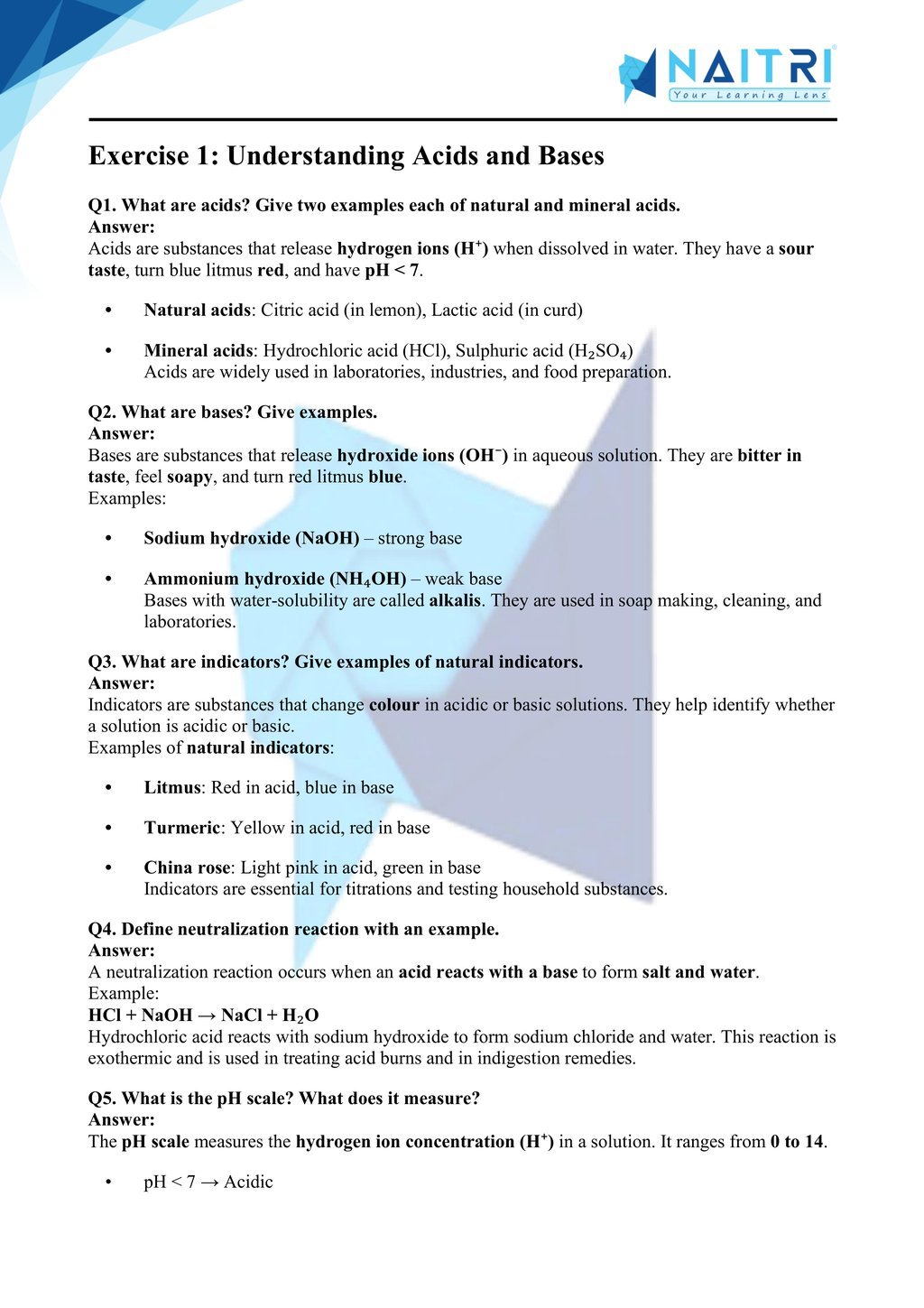
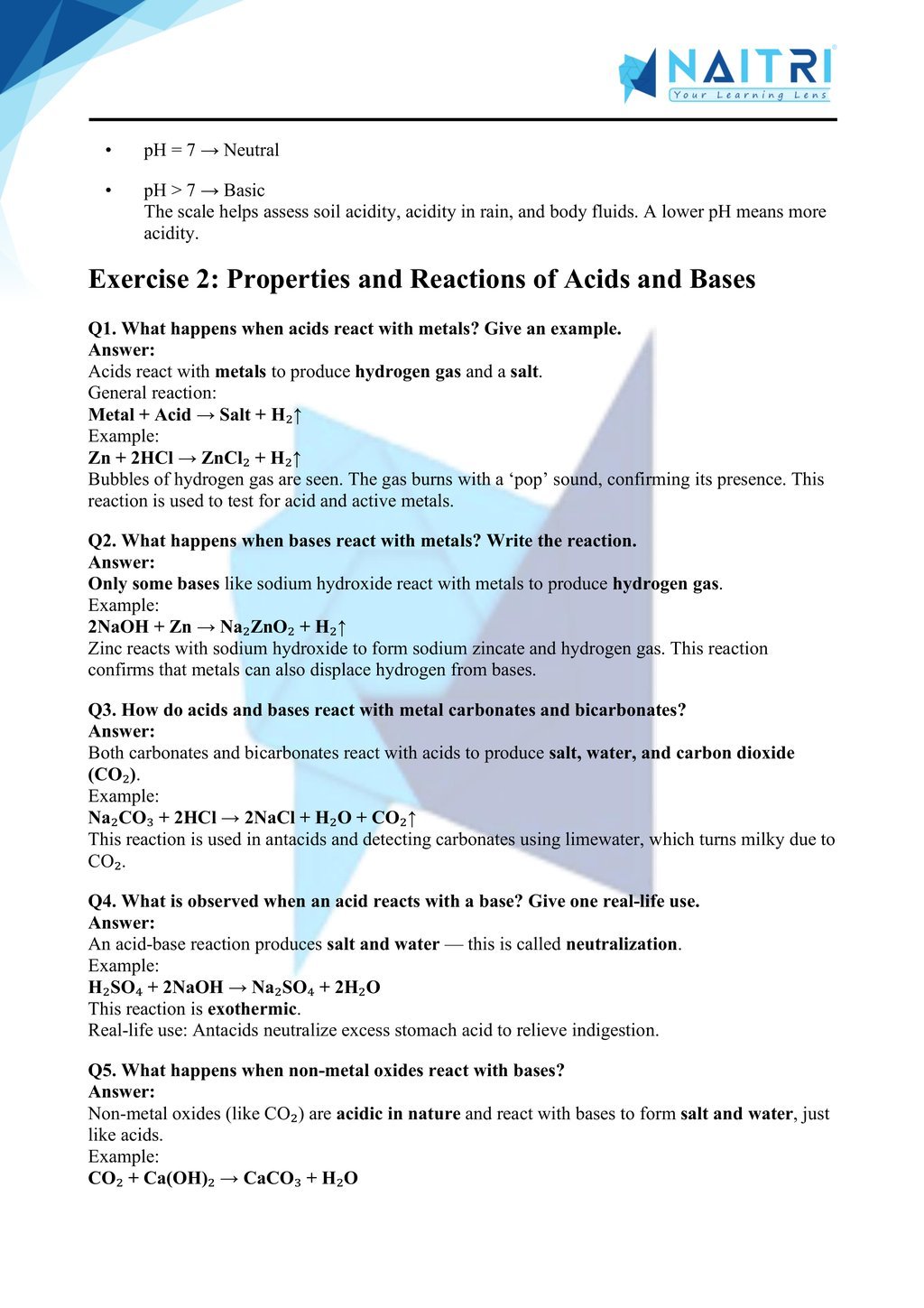
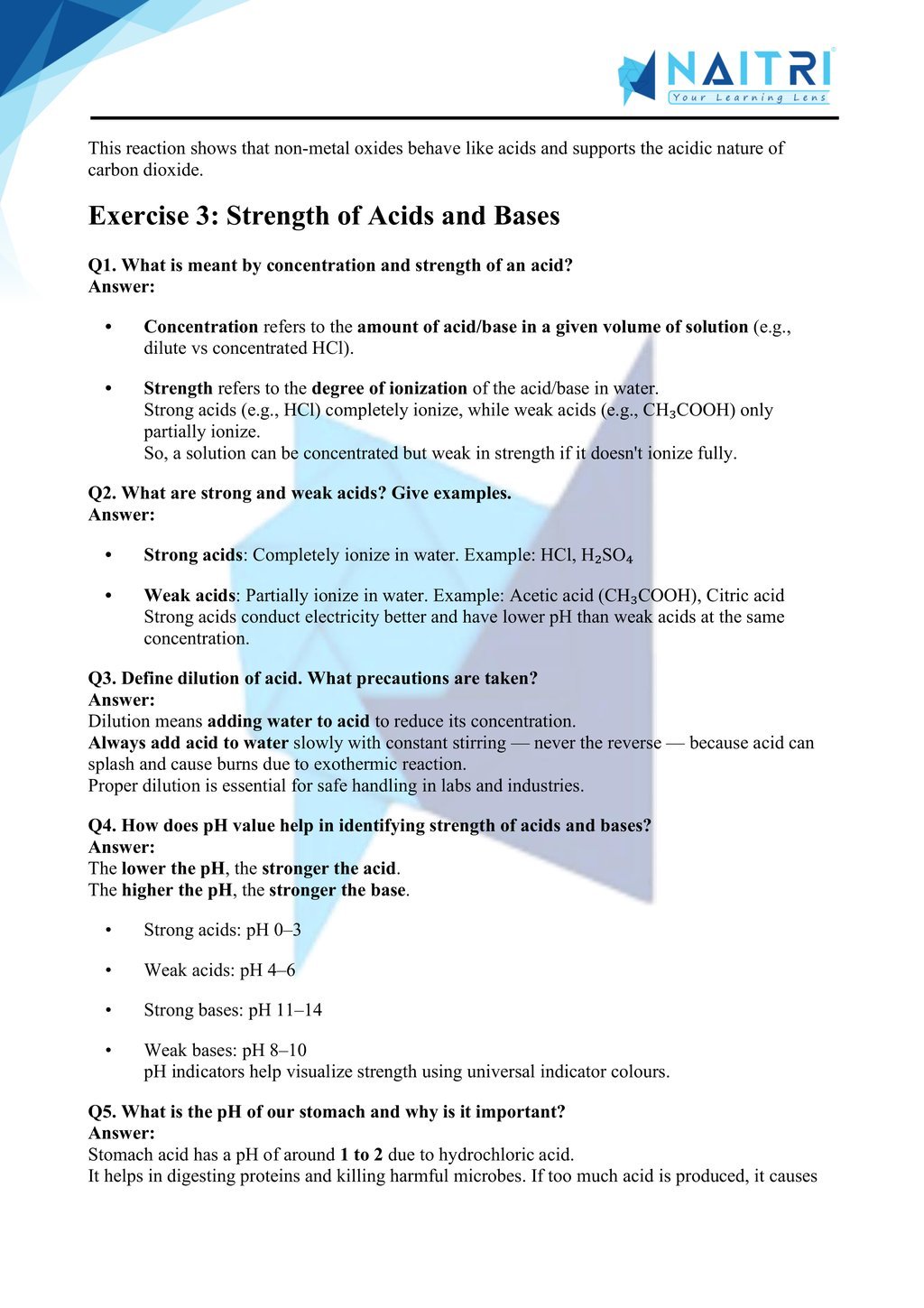
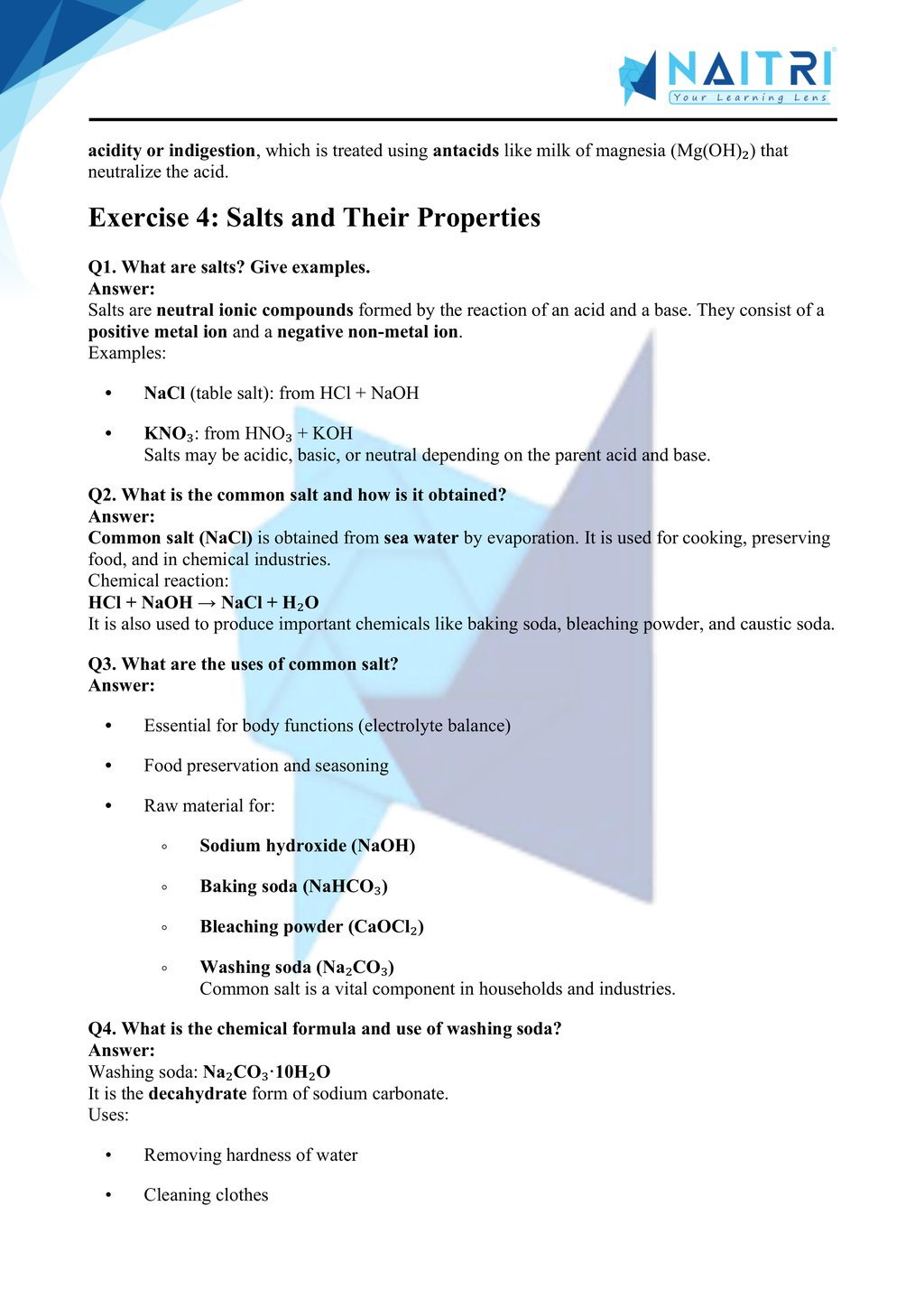
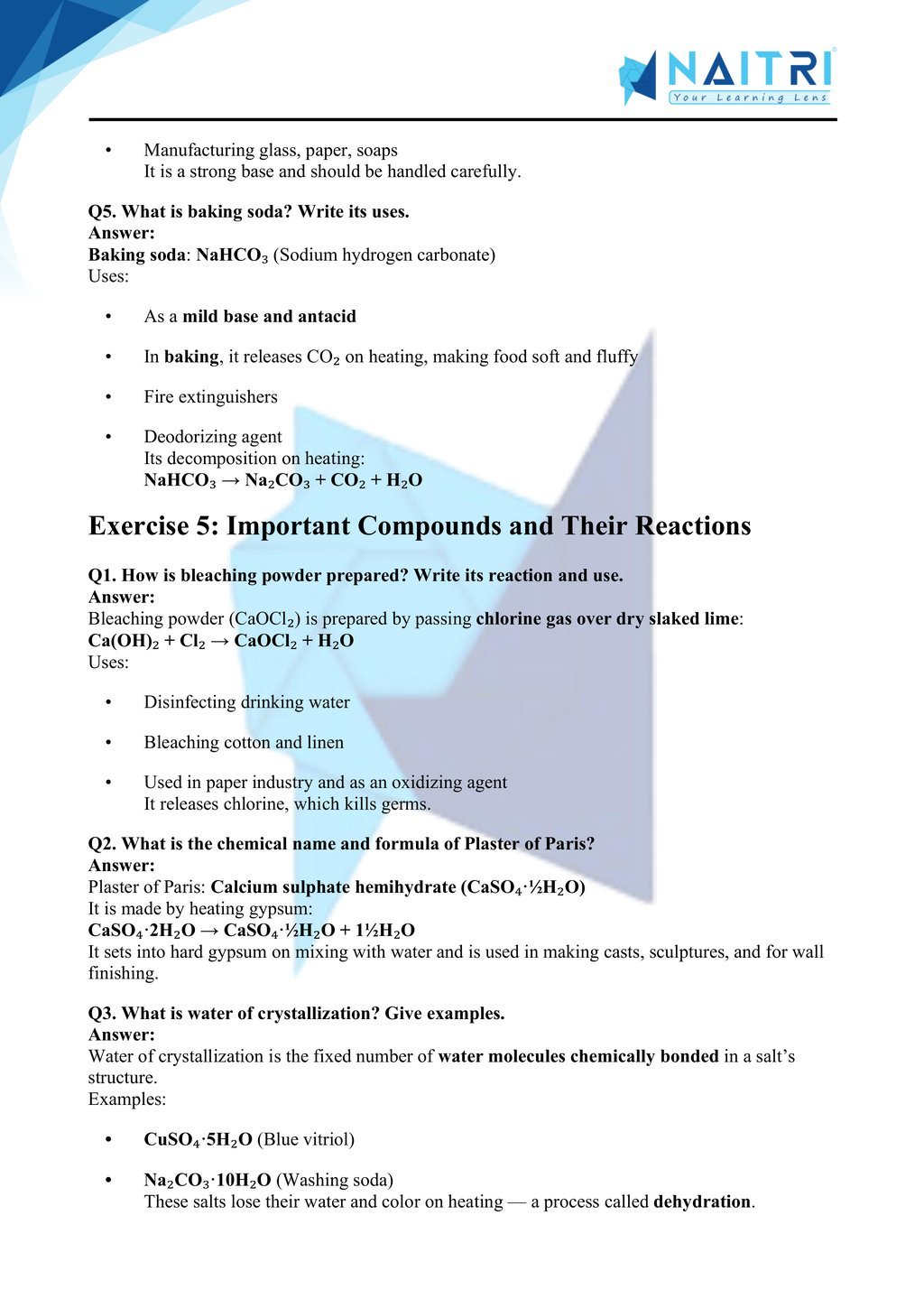
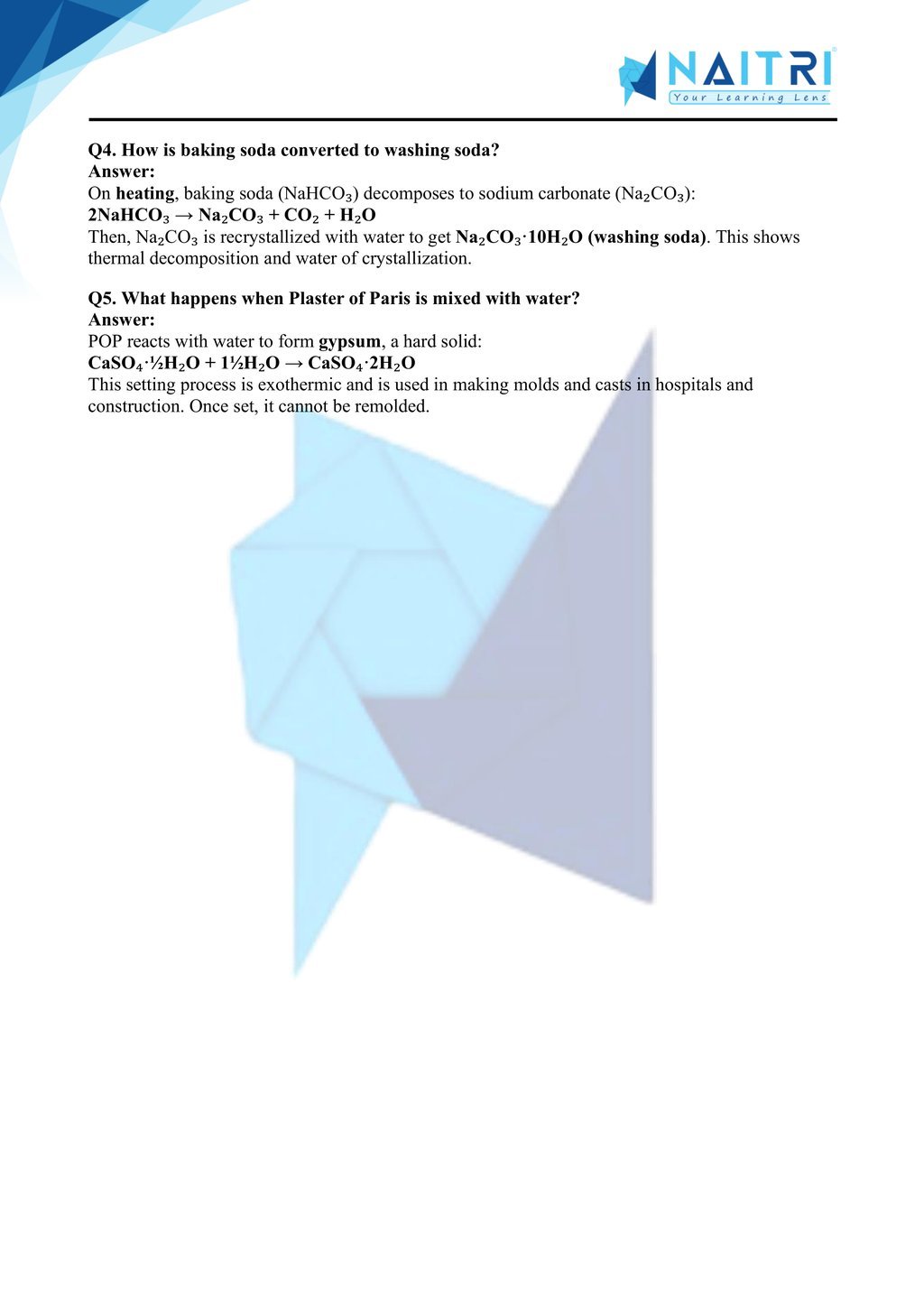
Experience Science Like Never Before – With AR!
Understanding Acids, Bases and Salts is now more exciting and immersive! With the NAITRI App, you can explore complex science concepts through Augmented Reality (AR). See acids fizz, bases neutralize, and pH indicators change color — right in front of you. Our AR-powered lessons make learning interactive, 3D, and fun, helping you retain concepts better and enjoy every topic.



Visualize . Interact . Understand . The future of learning is here
Acids, Bases and Salts – Important Questions with Answers
1. Define an acid and a base, and provide one example of each.
Answer: An acid is a substance that releases hydrogen ions (H⁺) when dissolved in water. For example, hydrochloric acid found in our stomach releases H⁺. A base releases hydroxide ions (OH⁻) in aqueous solution. For instance, sodium hydroxide used in drain cleaners releases OH⁻.
2. Explain the pH scale and its practical significance.
Answer: The pH scale ranges from 0 to 14 to indicate acidity or basicity of solutions. Values below 7 are acidic, above 7 are basic, and exactly 7 is neutral. It helps in understanding soil health, medicine, and water quality, making it extremely useful in daily life.
3. Why is pure water considered neutral with pH = 7?
Answer: Pure water undergoes self-ionization, producing equal concentrations of H⁺ and OH⁻ (10⁻⁷ M each), leading to a pH of 7. Since H⁺ equals OH⁻, water is neither acid nor base, making it neutral and ideal for biological systems.
4. List two natural indicators and describe their color change in acid and base.
Answer: Red cabbage juice turns pink/red in acidic solutions and green/blue in basic ones. Turmeric powder remains yellow in acidic or neutral solutions and becomes reddish-brown in alkaline conditions, useful for testing household substances’ acidity or alkalinity.
5. How can sodium chloride be prepared from dilute hydrochloric acid and sodium hydroxide solution?
Answer: Sodium chloride forms when hydrochloric acid (HCl) and sodium hydroxide (NaOH) react: HCl + NaOH → NaCl + H₂O. The water can be evaporated to obtain solid NaCl crystals, a process used widely in laboratories and salt production.
6. What is neutralization reaction? Give an example and related chemical equation.
Answer: A neutralization reaction occurs when an acid reacts with a base, producing salt and water, and neutralizing each other’s properties. Example: HCl + NaOH → NaCl + H₂O. This equilibrium is extensively applied in industries and daily life, such as treating acid indigestion.
7. Define salts and give two examples with their uses.
Answer: Salts are ionic compounds resulting from neutralization between acids and bases. For instance, sodium chloride (NaCl) is used in cooking and preserving food; calcium sulfate (CaSO₄) is used in making plaster. Each has practical applications based on its chemical properties.
8. What are basic salts and acidic salts? Provide one example of each.
Answer: Basic salts are formed when a strong base neutralizes a weak acid, leaving slight basic properties—for example, sodium carbonate. Acidic salts come from strong acids and weak bases, such as sodium hydrogen sulfate (NaHSO₄), showing weak acidic nature in solution.
9. Describe the laboratory method to prepare hydrogen gas using dilute acids.
Answer: In the lab, dilute hydrochloric or sulfuric acid is added to zinc granules. The reaction produces hydrogen gas: Zn + 2HCl → ZnCl₂ + H₂↑. The gas is collected by downward water displacement. This is a standard introductory method for demonstrating hydrogen gas.
10. Explain the preparation of oxygen gas in laboratory conditions.
Answer: Oxygen is typically prepared by decomposing hydrogen peroxide catalytically using manganese dioxide (MnO₂): 2H₂O₂ → 2H₂O + O₂. The liberated oxygen is captured over water. This reaction is simple, safe, and employed in school laboratories to produce oxygen.
11. What is the formula and common name for baking soda and washing soda?
Answer: Baking soda is sodium hydrogen carbonate (NaHCO₃). Washing soda is sodium carbonate decahydrate (Na₂CO₃·10H₂O). Baking soda is used in cooking and antacids; washing soda is used in laundry for cleaning and water softening.
12. How do antacids work to relieve acidity? Provide an example.
Answer: Antacids are basic substances like magnesium hydroxide or aluminum hydroxide. They neutralize excess stomach acid (HCl), raising the pH toward neutral and relieving indigestion and heartburn. For example: Mg(OH)₂ + 2HCl → MgCl₂ + 2H₂O.
13. Describe the preparation of gypsum from plaster of Paris.
Answer: Plaster of Paris is calcium sulfate hemihydrate (CaSO₄·½H₂O). When mixed with water, it hardens to form gypsum: CaSO₄·½H₂O + 1½H₂O → CaSO₄·2H₂O. The exothermic hardening process is used in recovery casts and building materials.
14. Explain the reaction of chlorine gas with sodium hydroxide solution.
Answer: Chlorine reacts with cold dilute NaOH to form sodium chloride (NaCl), sodium hypochlorite (NaOCl), and water: Cl₂ + 2NaOH → NaCl + NaOCl + H₂O. Sodium hypochlorite is used for bleaching and disinfection in household cleaners.
15. What is the difference between a strong acid and a weak acid? Give an example of each.
Answer: Strong acids fully ionize in solution (e.g., HCl), releasing all hydrogen ions. Weak acids partially ionize (e.g., acetic acid). This results in different pH levels and reactivity. Their applications vary, such as cooking vs. industrial cleaning.
16. Why is pH paper useful in labs and what range does it typically cover?
Answer: pH paper turns different colors depending on acidity or alkalinity, covering approximately pH 1–14. Acidic solutions (<7) yield red or orange, neutral yields green, and alkaline (>7) yields blue to violet, providing quick, approximate pH values for various solutions.
17. How is bleaching powder chemically composed and what is its use in water treatment?
Answer: Bleaching powder (CaOCl₂) is produced by passing chlorine over slaked lime (Ca(OH)₂), forming calcium oxychloride. It releases chlorine which acts as a disinfectant. It’s widely used in water treatment to kill bacteria, control algae, and purify drinking water.
18. Describe how soaps clean oily substances using acid-base principles.
Answer: Soap is a salt formed by saponification—reaction of fatty acids with a strong base like NaOH—producing carboxylate ions. These molecules have hydrophobic tails and hydrophilic heads, allowing them to emulsify oil in water, enabling mechanical removal of grease.
19. Define phenolphthalein and methyl orange indicators and their color changes.
Answer: Phenolphthalein is a colorless indicator in acids that turns pink in basic solutions with pH above 8.2. Methyl orange changes from red in acids (pH ~3) to yellow in bases (pH ~10). Both are widely used in titrations to detect endpoints.
20. Explain the reaction between baking soda and acetic acid found in vinegar.
Answer: Baking soda (NaHCO₃) reacts with acetic acid (CH₃COOH) in vinegar to form sodium acetate, water, and carbon dioxide gas: NaHCO₃ + CH₃COOH → CH₃COONa + CO₂↑ + H₂O. This fizzing reaction is used to demonstrate gas evolution.
21. How does lime water test for presence of carbon dioxide gas?
Answer: Lime water (calcium hydroxide solution) turns milky in presence of CO₂ due to formation of insoluble calcium carbonate (CaCO₃): CO₂ + Ca(OH)₂ → CaCO₃↓ + H₂O. This classic qualitative test detects carbon dioxide in labs.
22. Describe the dangers of acid-base reactions happening in the human body.
Answer: Acid-base imbalances in the human body can cause health hazards. For instance, overproduction of acid can lead to stomach ulcers, while excess base can cause alkalosis. Homeostatic mechanisms like buffering and kidney function maintain required balance for living organisms.
23. What is the chemical reaction between bicarbonate in antacids and stomach acid?
Answer: Sodium bicarbonate (NaHCO₃) reacts with hydrochloric acid in the stomach to produce sodium chloride, water, and carbon dioxide: NaHCO₃ + HCl → NaCl + H₂O + CO₂↑. It effectively neutralizes excess acid, providing instant relief from indigestion.
24. Explain how soil pH can be managed for agricultural purposes.
Answer: Soil pH impacts crop health. Acidic soils can be neutralized by adding lime (calcium carbonate), whereas alkaline soils can be treated with sulfur or gypsum. Getting soil to pH 6–7 improves nutrient availability and plant growth, aiding better yields.
25. Write the balanced chemical equation for the reaction between sodium carbonate and hydrochloric acid. Describe the products.
Answer: The balanced reaction is Na₂CO₃ + 2HCl → 2NaCl + H₂O + CO₂↑. Products formed include soluble sodium chloride (table salt), water, and carbon dioxide gas, frequently used in experiments to produce CO₂ with fizzing indication.
Acids, Bases and Salts explores the physical and chemical properties of acids and bases. The concept of pH is introduced along with indicators, neutralization reactions, and practical applications like antacids and soil treatment. Common salts such as sodium chloride, baking soda, and bleaching powder are discussed to help students understand their everyday importance and industrial relevance.
Related Chapters You May Like
Download Naitri App
Easy, Visual Learning — Right on Your Phone
Learn with Augmented Reality! The Naitri app makes CBSE and MP Board concepts interactive and fun — even in low-resource settings. Watch lessons, complete homework, take tests, and track progress — all in one place. Anytime. Anywhere.
Available on








